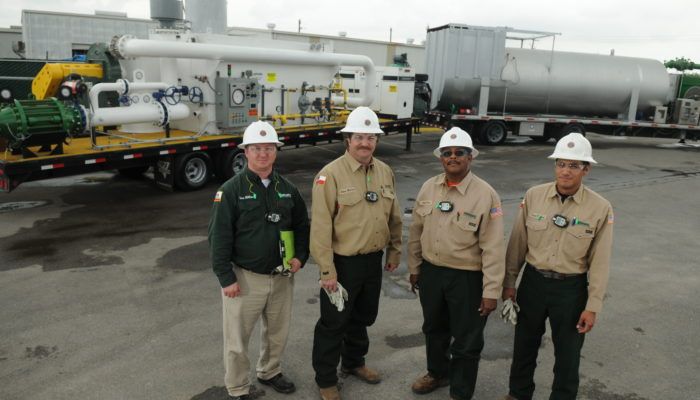Challenge
A customer came to Envent with an invitation to bid on an upcoming tank degas project. It was stated that facility storage tank 395 was to be degassed, cleaned, and then demolished. The external floating roof tank had been in slop oil service. By the time of bidding, the tank had been decommissioned for several years. The tank was approximately 100′ in diameter and 40′ shell height. Since the roof had landed on its legs a few years earlier, the customer was sure vapors were minimal. The logic being the vapor pressure would have pushed past the roof seals over time, venting the contents to atmosphere. Envent prepared a proposal that considered the customer’s assertion the tank would need minimal degassing. Also included was an additional degas duration that took into account a realistic duration given the release of vapors likely released when the sludge inside the tank was stirred. Envent’s expertise in tank degassing over the past 25 years provides the customer a vast library of scenarios and typical outcomes. Also included was a very important notice to the customer that Envent would not begin degas procedures until it was positively confirmed and proven no pyrophoric material was present. Envent includes this message on all proposals for tanks of this type due to the unknown nature of “Slop” and the explosive risks.
Solution
A few days after bidding was closed, Envent followed up with the customer on the proposal submitted. The customer informed the account manager that Envent’s proposal seemed excessive in its duration and that no pyrophorics were present. Again, the logic being this tank has been venting to atmosphere for a few years. If pyrophorics were present the tank would have overheated years ago. “All I need to do is satisfy a requirement to degas.” Envent was not awarded the tank 395 degas project due to price. About two weeks after the award of the project, local news outlets ran a breaking story of an explosion and fire at a local petroleum processing facility. Photos on the news showed the shell of tank 395 partially caved in and smoke billowing from inside. Aerial photos showed the tank roof lying flat on the ground about 20′ from the tank. The ensuing investigation determined that incomplete degassing and a pyrophoric reaction inside the tank had caused an explosion that launched the floating roof several feet into the air. Except for a few cuts, bruises, and rattled nerves, thankfully nobody was injured! Envent has always asked about the possible presence of pyrophoric material. Hindsight is always 20/20, but the customer would agree, Envent’s precautions were valid and warranted.
Benefits
Envent brings experience to the project site. With experience comes the knowledge to ask the right questions. In this case, asking about the presence of pyrophoric material was one aspect. The follow-up on the answer is just as important. If the answer in “No” to pyrophorics, can you prove it is “No” with a lab sample and analysis? If the customer does not provide the information needed to safely perform the degas, should you still proceed? Why ask for the information if you’re going ahead anyway? Another benefit of experience is being knowledgeable enough to enforce safety boundaries. Just because a customer provides a Purchase Order that does not mean your degassing provider should do the work at any cost. Certainly not the cost of equipment or facility damage, or worse…

